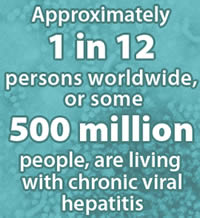Difference between Types of Hepatitis
Key difference: Hepatitis is a disease caused by various viruses. It mainly causes inflammation of the liver and is characterized by the presence of inflammatory cells in the tissue of the liver. The condition may be self-limiting, which means that it heals on its own over time or it may lead to fibrosis, i.e. scarring of the liver and cirrhosis. There are five different viruses that cause hepatitis: hepatitis A virus (HAV), hepatitis B virus (HBV), hepatitis C virus (HCV), hepatitis D virus (HDV) and hepatitis E virus (HEV). However, hepatitis can also be caused by toxic substances, such as alcohol, certain medications, some industrial organic solvents, plants, other infections and autoimmune diseases.
 Hepatitis is a disease caused by various viruses. It mainly causes inflammation of the liver and is characterized by the presence of inflammatory cells in the tissue of the liver. The condition may be self-limiting, which means that it heals on its own over time or it may lead to fibrosis, i.e. scarring of the liver and cirrhosis.
Hepatitis is a disease caused by various viruses. It mainly causes inflammation of the liver and is characterized by the presence of inflammatory cells in the tissue of the liver. The condition may be self-limiting, which means that it heals on its own over time or it may lead to fibrosis, i.e. scarring of the liver and cirrhosis.
People with hepatitis may or may show symptoms, in fact majority of the affected show limited or no symptoms. However, in those that do show symptoms, the common symptoms can include jaundice, anorexia, loss of appetite, malaise, abdominal pain, nausea, fever, diarrhea, fatigue, etc.
There are five different viruses that cause hepatitis: hepatitis A virus (HAV), hepatitis B virus (HBV), hepatitis C virus (HCV), hepatitis D virus (HDV) and hepatitis E virus (HEV). However, hepatitis can also be caused by toxic substances, such as alcohol, certain medications, some industrial organic solvents, plants, other infections and autoimmune diseases.
 All the various types of hepatitis can cause similar symptoms, hence it is quite difficult of diagnose the cause of the condition. However, blood test checking for levels of antibodies as particular to the individual viruses can help diagnose the responsible virus. However, the viruses have different modes of transmission and can affect the liver differently.
All the various types of hepatitis can cause similar symptoms, hence it is quite difficult of diagnose the cause of the condition. However, blood test checking for levels of antibodies as particular to the individual viruses can help diagnose the responsible virus. However, the viruses have different modes of transmission and can affect the liver differently.
Hepatitis can be acute or chronic. Acute hepatitis is when it lasts less than six months and chronic when it persists longer. Hepatitis A appears only as an acute or newly occurring infection and does not become chronic. It also does not require treatment. Hepatitis B and Hepatitis C can also begin as acute infections, however in some cases may turn into chronic diseases and cause long-term liver problems. Hepatitis D only affects people with Hepatitis B, and Hepatitis E is quite similar to Hepatitis A.
A detailed comparison of the five types of Hepatitis:
|
Hepatitis A |
Hepatitis B |
Hepatitis C |
Hepatitis D |
Hepatitis E |
|
Hepatitis A is inflammation of the liver caused by the hepatitis A virus. It can range in severity from a mild illness lasting a few weeks to a severe illness lasting several months. However, it is rarely fatal. |
Hepatitis B is a contagious liver disease that results from infection with the Hepatitis B virus (HBV). It can range in severity from a mild illness lasting a few weeks to a serious, lifelong illness. Hepatitis B can be either “acute” or “chronic”. |
Hepatitis C is a contagious liver disease that results from infection with the Hepatitis C virus. It can range in severity from a mild illness lasting a few weeks to a serious, lifelong illness. Hepatitis C can be either “acute” or “chronic.” |
Hepatitis D is a disease that results from infection with the Hepatitis D virus, also known as HDV. It is a subviral satellite because it can propagate only in the presence of the hepatitis B virus (HBV). |
Hepatitis E is a contagious liver disease that results from infection with the Hepatitis E virus (HEV). |
|
The hepatitis A virus is found in the stool of people with hepatitis A. It is most commonly transmitted in drinking water or food contaminated with the stool containing the virus. |
Hepatitis B is a sexually transmitted disease (STD). It is spread by contact with an infected person's blood, semen, or other body fluid. |
The hepatitis C virus is transmitted through contact with the blood of an infected person. Hepatitis C causes swelling of the liver and can cause liver damage that can lead to cancer. May lead to a scarring of the liver, called cirrhosis. |
The hepatitis D virus infected people already with the hepatitis B virus. It is spread through contact with infected blood, dirty needles that have HDV on them, and unprotected sex (not using a condom) with a person infected with HDV. Hepatitis D causes swelling of the liver. It increases likelihood for liver failure, faster progression to liver cirrhosis, and increased chance of developing liver cancer. |
The hepatitis E virus is found in the stool of people with hepatitis E. It is most commonly transmitted in drinking water or food contaminated with the stool containing the virus. |
|
Living with an infected person. Having sex, especially anal with an infected person. Traveling to countries where hepatitis A is common. Injecting and non-injecting drug users. Children and employees in child care settings. People who had a Hepatitis A infection in the last six to nine months. |
Hepatitis B virus is transmitted between people by direct blood-to-blood contact or semen and vaginal fluid of an infected person. Hepatitis B is an important occupational hazard for health workers. common modes of transmission are: Perinatal (from mother to baby at birth) Early childhood infections (inapparent infection through close interpersonal contact with infected household contacts) Unsafe injection practices Unsafe blood transfusions Unprotected sexual contact. |
The hepatitis C virus is transmitted through contact with the blood of an infected person. This can occur through: Receipt of contaminated blood transfusions, blood products and organ transplants; Injections given with contaminated syringes and needle-stick injuries in health-care settings; Injection drug use; Perinatal (from mother to baby at birth) Sex with an infected person or sharing of personal items contaminated with infectious blood (rare). |
As Hepatisis D only affects people with Hepatitis B, people with both have more severe complications than just Hepatitis B. The routes of transmission of hepatitis D are similar to Hepatitis B, particularly for injecting drug users and persons receiving clotting factor concentrates. |
Transmitted mainly through the fecal-oral route due to fecal contamination of drinking water. Food borne transmission from ingestion of products derived from infected animals. Zoonotic transmission from animals to humans. Transfusion of infected blood products. Vertical transmission from a pregnant woman to her fetus. |
|
Vaccination against hepatitis A is available and recommended for people at risk, who are above the age of 1 year. Also maintain physical hygiene, and avoid drinking impure water or uncooked food. |
Hepatitis B vaccine is main prevention technique for Hepatitis B. |
There is currently no vaccine for hepatitis C; however, research in this area is ongoing. The risk of infection can be reduced by avoiding: unnecessary and unsafe injections; unsafe blood products; unsafe sharps waste collection and disposal; use of illicit drugs and sharing of injection equipment; unprotected sex with hepatitis C-infected people; sharing of sharp personal items that may be contaminated with infected blood; tattoos, piercings and acupuncture performed with contaminated equipment. |
The vaccine for prevention of Hepatitis B, also protects against Hepatitis D, as Hepatitis D cannot incubate if there is no Hepatitis B. |
In 2011, the first vaccine to prevent hepatitis E infection was registered in China. However, not currently available globally. Also maintain physical hygiene, and avoid drinking impure water or uncooked food, especially shellfish. |
|
Most people do not experience any symptoms during the acute infection phase. Symptoms last several weeks, and include: Yellowing of the skin and eyes (jaundice), dark urine, extreme fatigue, nausea, vomiting and abdominal pain. |
Most people do not experience any symptoms during incubation period. Symptoms include:
|
Similar to other types of hepatitis viruses, including: Yellowing of the skin and eyes (jaundice), dark urine, extreme fatigue, nausea, vomiting and abdominal pain. |
|
|
Blood tests can used to diagnose hepatitis A. |
Blood tests to test for antibodies to the hepatitis B surface antigen or for antibodies to the hepatitis B core antigen. |
Diagnosis of acute infection is often missed because a majority of infected people have no symptoms. Blood tests, testing for presence of antibodies against the hepatitis C virus are used to confirm diagnosis. The hepatitis C virus recombinant immunoblot assay (RIBA) and hepatitis C virus RNA testing are used to confirm the diagnosis. |
Blood tests can used to diagnose hepatitis D. |
Blood tests for detection of specific antibodies to the virus. May also require reverse transcriptase polymerase chain reaction (RT-PCR) to detect the hepatitis E virus RNA or immune electron microscopy to detect the hepatitis E virus. |
|
Hepatitis A causes acute (short-lived) infection. The liver heals itself over a few weeks to months. No treatment is |
There is no specific treatment for acute hepatitis B. Care is aimed at maintaining comfort and adequate nutritional balance, including replacement of fluids that are lost from vomiting and diarrhoea. Some people with chronic hepatitis B can be treated with drugs, including interferon and antiviral agents. |
Hepatitis C does not always require treatment. There are 6 genotypes of hepatitis C and they may respond differently to treatment. Combination antiviral therapy with interferon and ribavirin is commonly used to treat Hepatitis C. |
There is no specific treatment for hepatitis D. Hepatitis D is a viral disease, and as such, antibiotics are of no value in the treatment of the infection. A-interferon may be used to improve conditions. Liver transplantation may be considered for cases of fulminant acute and end-stage chronic hepatitis D. |
Hepatitis E is a self-limiting infection and automatically resolves within 4–6 weeks. |
|
Globally, there are an estimated 1.4 million cases of hepatitis A every year. |
Two billion people worldwide have been infected with the virus and about 600 000 people die every year due to the consequences of hepatitis B. The hepatitis B virus is 50 to 100 times more infectious than HIV. |
About 150 million people are chronically infected with hepatitis C virus, and more than 350 000 people die every year from hepatitis C-related liver diseases. |
HDV is rare in most developed countries, and is mostly associated with intravenous drug use. In all, about 20 million people worldwide may be infected with HDV. |
Every year there are 20 million hepatitis E infections, over three million acute cases of hepatitis E, and 70 000 hepatitis E-related deaths. |
Image Courtesy: kidshealth.org, cdc.gov









Add new comment